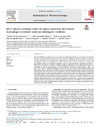Identificador persistente para citar o vincular este elemento:
https://accedacris.ulpgc.es/jspui/handle/10553/114048
| Campo DC | Valor | idioma |
|---|---|---|
| dc.contributor.author | Fernández-García, Victoria | en_US |
| dc.contributor.author | González-Ramos, Silvia | en_US |
| dc.contributor.author | Avendaño-Ortiz, José | en_US |
| dc.contributor.author | Martín-Sanz, Paloma | en_US |
| dc.contributor.author | Delgado, Carmen | en_US |
| dc.contributor.author | Castrillo Viguera, Antonio Jesús | en_US |
| dc.contributor.author | Boscá, Lisardo | en_US |
| dc.date.accessioned | 2022-03-14T09:07:45Z | - |
| dc.date.available | 2022-03-14T09:07:45Z | - |
| dc.date.issued | 2022 | en_US |
| dc.identifier.issn | 0753-3322 | en_US |
| dc.identifier.other | Scopus | - |
| dc.identifier.uri | https://accedacris.ulpgc.es/handle/10553/114048 | - |
| dc.description.abstract | The bioavailability and regulation of iron is essential for central biological functions in mammals. The role of this element in ferroptosis and the dysregulation of its metabolism contribute to diseases, ranging from anemia to infections, alterations in the immune system, inflammation and atherosclerosis. In this sense, monocytes and macrophages modulate iron metabolism and splenic function, while at the same time they can worsen the atherosclerotic process in pathological conditions. Since the nucleotide-binding oligomerization domain 1 (NOD1) has been linked to numerous disorders, including inflammatory and cardiovascular diseases, we investigated its role in iron homeostasis. The iron content was measured in various tissues of Apoe-/- and Apoe-/-Nod1-/- mice fed a high-fat diet (HFD) for 4 weeks, under normal or reduced splenic function after ligation of the splenic artery. In the absence of NOD1 the iron levels decreased in spleen, heart and liver regardless the splenic function. This iron decrease was accompanied by an increase in the recruitment of F4/80+-macrophages in the spleen through a CXCR2-dependent signaling, as deduced by the reduced recruitment after administration of a CXCR2 inhibitor. CXCR2 mediates monocyte/macrophage chemotaxis to areas of inflammation and accumulation of leukocytes in the atherosclerotic plaque. Moreover, in the absence of NOD1, inhibition of CXCR2 enhanced atheroma progression. NOD1 activation increased the levels of GPX4 and other iron and ferroptosis regulatory proteins in macrophages. Our findings highlight the preeminent role of NOD1 in iron homeostasis and ferroptosis. These results suggest promising avenues of investigation for the diagnosis and treatment of iron-related diseases directed by NOD1. | en_US |
| dc.language | eng | en_US |
| dc.relation.ispartof | Biomedicine and Pharmacotherapy | en_US |
| dc.source | Biomedicine and Pharmacotherapy [ISSN 0753-3322], v. 148, 112769, (Abril 2022) | en_US |
| dc.subject | 2403 Bioquímica | en_US |
| dc.subject.other | Atherosclerosis | en_US |
| dc.subject.other | CXCR2 | en_US |
| dc.subject.other | Ferroptosis | en_US |
| dc.subject.other | Iron | en_US |
| dc.subject.other | Macrophages | en_US |
| dc.subject.other | NOD1 | en_US |
| dc.title | NOD1 splenic activation confers ferroptosis protection and reduces macrophage recruitment under pro-atherogenic conditions | en_US |
| dc.type | info:eu-repo/semantics/Article | en_US |
| dc.type | Article | en_US |
| dc.identifier.doi | 10.1016/j.biopha.2022.112769 | en_US |
| dc.identifier.scopus | 85125632605 | - |
| dc.contributor.orcid | NO DATA | - |
| dc.contributor.orcid | NO DATA | - |
| dc.contributor.orcid | NO DATA | - |
| dc.contributor.orcid | NO DATA | - |
| dc.contributor.orcid | NO DATA | - |
| dc.contributor.orcid | NO DATA | - |
| dc.contributor.orcid | NO DATA | - |
| dc.contributor.authorscopusid | 57201801330 | - |
| dc.contributor.authorscopusid | 56041607200 | - |
| dc.contributor.authorscopusid | 57163917300 | - |
| dc.contributor.authorscopusid | 57196054763 | - |
| dc.contributor.authorscopusid | 55428853800 | - |
| dc.contributor.authorscopusid | 55445301000 | - |
| dc.contributor.authorscopusid | 35514045400 | - |
| dc.identifier.eissn | 1950-6007 | - |
| dc.relation.volume | 148 | en_US |
| dc.investigacion | Ciencias de la Salud | en_US |
| dc.type2 | Artículo | en_US |
| dc.utils.revision | Sí | en_US |
| dc.date.coverdate | Abril 2022 | en_US |
| dc.identifier.ulpgc | Sí | en_US |
| dc.contributor.buulpgc | BU-MED | en_US |
| dc.description.sjr | 1,366 | |
| dc.description.jcr | 7,5 | |
| dc.description.sjrq | Q1 | |
| dc.description.jcrq | Q1 | |
| dc.description.scie | SCIE | |
| dc.description.miaricds | 11,0 | |
| item.fulltext | Con texto completo | - |
| item.grantfulltext | open | - |
| crisitem.author.dept | GIR IUIBS: Farmacología Molecular y Traslacional | - |
| crisitem.author.dept | IU de Investigaciones Biomédicas y Sanitarias | - |
| crisitem.author.orcid | 0000-0002-2057-2159 | - |
| crisitem.author.parentorg | IU de Investigaciones Biomédicas y Sanitarias | - |
| crisitem.author.fullName | Castrillo Viguera, Antonio Jesús | - |
| Colección: | Artículos | |
Citas SCOPUSTM
23
actualizado el 08-jun-2025
Citas de WEB OF SCIENCETM
Citations
20
actualizado el 08-jun-2025
Visitas
67
actualizado el 11-may-2024
Descargas
121
actualizado el 11-may-2024
Google ScholarTM
Verifica
Altmetric
Comparte
Exporta metadatos
Los elementos en ULPGC accedaCRIS están protegidos por derechos de autor con todos los derechos reservados, a menos que se indique lo contrario.
